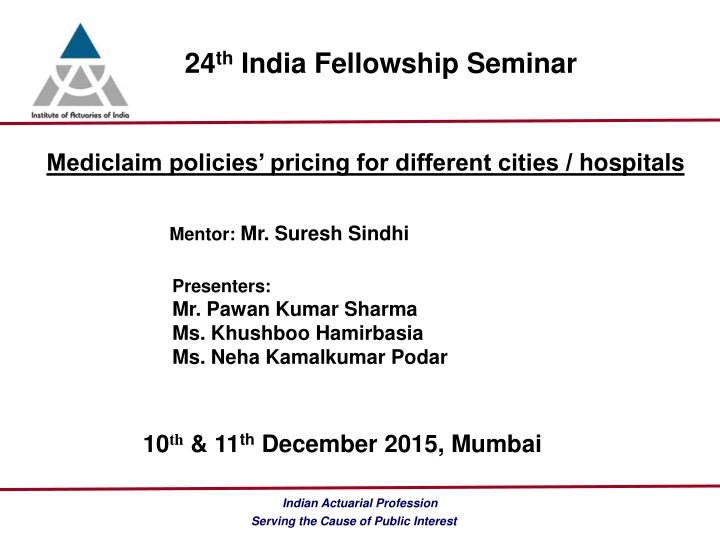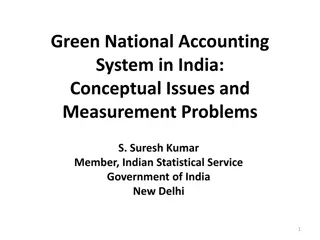
Insights into Mediclaim Pricing and Industry in India
Explore the dynamics of mediclaim pricing and the insurance industry in India, covering city-based and hospital-based policies. Gain knowledge on current trends, industry growth, and factors influencing pricing. Discover key players and regulations shaping the mediclaim landscape.
Download Presentation

Please find below an Image/Link to download the presentation.
The content on the website is provided AS IS for your information and personal use only. It may not be sold, licensed, or shared on other websites without obtaining consent from the author. If you encounter any issues during the download, it is possible that the publisher has removed the file from their server.
You are allowed to download the files provided on this website for personal or commercial use, subject to the condition that they are used lawfully. All files are the property of their respective owners.
The content on the website is provided AS IS for your information and personal use only. It may not be sold, licensed, or shared on other websites without obtaining consent from the author.
E N D
Presentation Transcript
24th India Fellowship Seminar Mediclaim policies pricing for different cities / hospitals Mentor: Mr. Suresh Sindhi Presenters: Mr. Pawan Kumar Sharma Ms. Khushboo Hamirbasia Ms. Neha Kamalkumar Podar 10th & 11th December 2015, Mumbai Indian Actuarial Profession Serving the Cause of Public Interest
Agenda Mediclaim Industry In India Current Mediclaim Pricing In India City Based Mediclaim Pricing Hospital Based Mediclaim Pricing
MEDICLAIM INDUSTRY IN INDIA
Mediclaim Insurance Industry in India What is Mediclaim? Indemnity based hospitalization product Short term up to 3 years Companies offering Mediclaim products: 4 PSUs 20 Private Insurance players (AIC, ECGC, R-QBE, Shriram, Magma HDI & Kotak not offering yet) 5 Stand alone Health insurance companies www.actuariesindia.org 4
Business Composition Share of LOBs in GI GWP for Health - Breakup by Segment 17% 26% 32% GOVERNMENT 43% MOTOR GROUP HEALTH FAMILY FLOATER OTHERS 11% INDIVIDUAL 46% 25% Health segment is the second largest contributor to the non-life industry s premium Increasing importance of Health Segment in Portfolio Group business contributes the most, Retail policies gaining share with awareness Source: Segment-wise report Oct-2015, IIB Annual report 2013-14, IRDA www.actuariesindia.org 5
Industry Size Growth In Health Insurance 25000 15% CAGR 20000 20,443 17,620 15000 15,302 13,211 10000 5000 GWP (in Cr) 0 2011 2012 2013 2014 Loss Ratio around 100% due to loss-making Group business Source: Segment-wise report Mar-2015, IIB Annual report 2013-14, IRDA www.actuariesindia.org 6
CURRENT MEDICLAIM PRICING IN INDIA www.actuariesindia.org 7
Current Mediclaim Pricing RATING FACTORS MODELLING REGULATIONS Exposure Based Rating using Generalised Linear Modelling (GLM) Age Sum Assured Gender Room Rent Limit Geography Deductible Price Revision allowed only after 3 years as per Health Regulation, 2013 www.actuariesindia.org 8
Pricing Model APS 21 Section 6.3 : Premium Rate Components The Appointed Actuary should also analyze the insurer s own claims experience and, where possible, compare it with the industry experience. The analysis should consider both claims frequency and claim size. Premium = (Frequency*Severity) + Expenses + Profit Age Deductible Geography Sum Insured Room-rent limit Age Gender Deductible Geography www.actuariesindia.org 9
CITY BASED MEDICLAIM PRICING www.actuariesindia.org 10
Thoughts to Ponder At Rs 40,179, Delhi s average claim size was 427% that of Jharkhand s Rs 9,403 At Rs 36,514, Maharashtra s average claim size was 320% that of Bihar s Rs 11,430 IS IT FAIR TO CHARGE THE SAME PREMIUM ACROSS INDIA? Source: Insurance Information Bureau of India www.actuariesindia.org 11
Why the difference? Frequency General Environment Conditions Standard of living Access to Healthcare Development of infrastructure Severity Affordability Medical advancements Supply of Medical services Medical Inflation www.actuariesindia.org 12
Claim Frequency STATE FREQUENCY (Per Policy) Maharashtra 15% Karnataka 28% Delhi 21% Tamil Nadu 16% West Bengal 20% Andhra Pradesh 26% Jharkhand 18% Source: Insurance Information Bureau of India (2012-13) www.actuariesindia.org 13
Medical Cost METRO CITY-WISE NUMBER OF CLAIMS AND AMOUNT OF CLAIMS PAID 2012-13 Metro City Number of Claims Total Claims Paid (Rs cr) Average Claim Paid (in Rs) 1,33,326 624.05 Mumbai 46,806 75,709 326.63 Bengaluru 43,143 1,26,126 506.76 Delhi 40,179 52,065 183.63 Chennai 35,269 87,207 294.72 Kolkata 33,795 62,435 207.23 Hyderabad 33,192 Having an angioplasty in Nasik or Pune would cost about Rs 2.5 lakhs and undergoing the same procedure in Mumbai (or Delhi) would cost Rs 4 lakhs Source: iib.org 2012-13 www.actuariesindia.org 14
How do we now classify? Rural v/s Urban? Huge disparity in Urban cost State wise? 29 States and 7 Union Territories Consider this Mumbai s average claim size is 70% higher than the rest of Maharashtra alone. City wise? 250+ cities in India www.actuariesindia.org 15
Zone Based Pricing Classification based on perceived level of risk Zones may be classified under Zone 1, 2 or 3 Metro cities fall in Zone 1 Tier-I cities fall in Zone 2 and The rest of India falls under Zone 3. Classification may vary from company to company Some companies that offer zone-based pricing: Max Bupa Health Insurance, L&T Health Insurance, CignaTTK Insurance, Star Health Insurance, New India Assurance, SBI General Insurance. www.actuariesindia.org 16
Existing demarcation Cities Cigna TTK ProHealth New India Assurance Max Bupa Mumbai, Thane, Navi Mumbai Zone 1 Zone 1 Delhi/NCR Bengaluru Hyderabad Chennai Chandigarh Ludhiana Kolkata Gujarat Pune Bhopal Jaipur Lucknow Patna North-East India Jharkhand, Orissa, Chhatisgarh J&K, Uttaranchal Zone 1 Zone 2 Zone 2 NA NA Zone 3 Zone 2 Zone 2 Zone 1 Zone 3 Zone 3 Zone 2 NA Zone 4 NA NA Source: Business Standard Sept 09,2015 www.actuariesindia.org 17
Advantages of Zone wise Banding Lower Cross-subsidies Help Maintain Uniformity in Claim Ratio May Increase Penetration in smaller cities Client Perception Management Help companies to achieve suitable Business Mix www.actuariesindia.org 18
Implementation challenges Which location? - Current residence or Permanent residence Sales Challenges Customer Grievances Loss of potential customers Lack of uniform classification Change in band definition Rate arbitration Global coverage Admin Complexities www.actuariesindia.org 19
HOSPITAL BASED MEDICLAIM PRICING www.actuariesindia.org 20
Definition of Hospital A hospital means any institution established for in- patient care and day care treatment of sickness and / or injuries and which has been registered as a hospital with the local authorities, wherever applicable, and is under the supervision of a registered and qualified medical practitioner AND must comply with all minimum criteria as under: has qualified nursing staff under its employment round the clock; has qualified medical practitioner(s) in charge round the clock; has a fully equipped operation theatre of its own where surgical procedures are carried out maintains daily records of patients and will make these accessible to the Insurance company s authorized personnel Source: Guidelines on Standardization in Health Insurance,2013 www.actuariesindia.org 21
Medical Cost Disparity MEDICAL BURDEN 40000 Cost of Treatment (in Rs) 35000 30000 25000 20000 15000 10000 5000 0 Child Birth 1852 17553 Eye 1778 13374 Injuries 6729 36255 Gastro 5281 23933 Lungs 4811 18705 Government Private Source: Times of India, July 9,2015 www.actuariesindia.org 22
Medical Cost Disparity Amount (In Rs.) Inpatient Stay Cost (Per day) Person Hospital Cataract Renal Stone Corporate Hospital A 9,949 113,237 141,286 C Private Hospital 6,996 56,500 44,047 Charitable hospital B 1,959 21,600 10,810 IS IT FAIR TO CHARGE THE SAME PREMIUM TO ALL OF THEM ? Source: The Hindu, July 26,2013 www.actuariesindia.org 23
Hospital based Pricing Variation in cost structure of healthcare : Human Resources Capital Resources Material Cost Policies can be offered for different classes of hospital with differential premium Significant Role of TPA in Banding Hospitals can be broadly banded as: Corporate Hospitals Private hospitals run by individuals Other smaller hospitals (Charitable hospitals, Missionary hospitals, Nursing homes etc ) IRDAI has provided unique hospital based IDs to about 30,000+ hospitals in India (Ref No. IIB/Cir/2014/3) - to determine pricing patterns for various diseases and collect information on the charges for different procedures. www.actuariesindia.org 24
Advantage of Hospital Based Banding Inclusion of low income customers in metro cities Need based selling Increased penetration Reduction in cross subsidy Linked to economic prosperity / Financial Inclusion www.actuariesindia.org 25
Implementation Challenges Loss of high end customers Administration complexity Claims management issues Reputational risk due to customer dis-satisfaction Mis-selling issues with co-pay Data Issues No standardization of Treatment Cost / Procedures www.actuariesindia.org 26
Alternatives Co-pay under hospital bands: Same Premium Rates across all hospital bands but different Co- pay levels Example : Corporate Hospitals with 30% Co-pay Smaller Private hospitals with 20% Co-pay Charitable hospitals with 10% Co-pay Co-pay can additionally be covered by Add-Ons Banding according to: Level of Care i.e., Primary, Secondary or Tertiary Number of beds Preferred and Non Preferred Hospitals www.actuariesindia.org 27
Conclusion Customer Centric Reduction in Cross Subsidies Achieve Desired Mix Increased Penetration Challenges Data Issues Complexity Administration Monitoring Regulatory Approval Standardization Training Communication www.actuariesindia.org 28
Q&A! THANK YOU! www.actuariesindia.org 29




